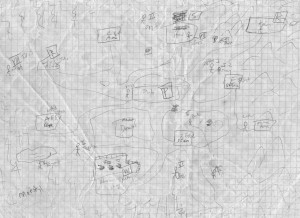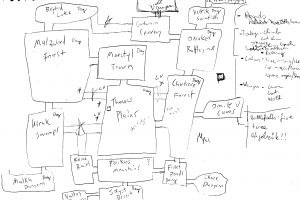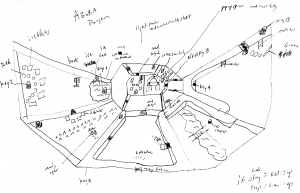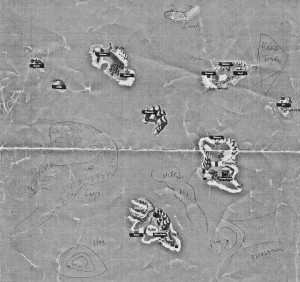This is continuing the series on Arvale Game Design from Part 2 here. If you missed Part 1, that’s here.
Welcome back! In the last chapter of this series on Arvale Game Designs, I’m going to touch on topics such as Quest Design, Semi-Persistent worlds, Day and Night cycles, more Maps, and perhaps even a few bits of information on Arvale: III. And of course, you can still make fun of my uh, unique handwriting 😉 We’ll be using examples from:
Arvale: Short Tales
I didn’t want the game to be Arvale III, as I promised I would never do Arvale III unless the game was in 3D. I’m still keeping that promise.
Choosing Short Tales instead of Short Stories was an aesthetic one so that the acronym was AST instead of ASS. 😉
The idea behind Short Tales was to have 4 (+1) short adventures that the player could choose from. Each with unique characters and story lines, but set within the same semi-persistent world (it can’ be fully persistent if you’re playing one character at a time). I must admit that Saga Frontier for Playstation 1 actually inspired quite a bit of the idea. I also wanted to play more with lots of mini-quests that were all intertwined, similar to how Quests in Everquest, Knights of the Old Republic, and World of Warcraft are designed.
And having all of this happen in the same world, starting in the same town, was surprisingly… actually, quite simple 🙂
You lose a bit with the grid paper, but if you zoom in on the pic, everything is clearly visible.
Having only one central town in the game meant that I could spend less time creating massive amounts of maps, NPCs, houses, and everything else that goes into a town. Given that all the NPCs would appear in each character’s story, this means that player’s would become more familiar with each character, so I was able to create a small back-story for each one (on another paper, that one is secret though), and I could give each NPC a unique name. You can see the names of most of the NPCs are already decided and written next to each beautiful stick figure or house already.
On the flip-side, because of the semi-persistent world, and unique characters, these same NPCs had to multiplied by 4. This was the easiest way for the NPCs to be able to interact with each player character with different texts, triggers, and Quests.
You may also notice letters ABCDEFGHIJK and roman numerals I-VIII. These were more or less unique IDs tied to Maestyl for buildings and NPCs which I could refer to throughout the design of the game.
Since there was only one central town in the game, this also meant that world surrounding it would have to be relatively small as well.
While nowhere as pretty as this map
It is a lot more informative during the design of how all the maps link together (including the map shortcuts which were essential during testing). I actually scrawled this map out for one of the other designers to help him with testing out the game. That’s why you’ll notice the different handwriting (no more legible at that, I’m telling you, designers…) written on the maps and to the side.
The ‘Day’ marks I imagine were the other designer trying to figure out how the Day/Night cycle I implemented worked 🙂 I implemented a Day/Night cycle into the game using a complicated set of triggers and flags which were more or less set based on how many times you switched maps and which maps you were switching to. The player could also switch the Day/Night by sleeping at the inn in the town.
Day/Night cycles led to an interesting choice for Quests. The NPC could tell the player that a certain task could only be performed at Night or during the Day. However, if the only way the player knew for sure to switch the Day cycle was by sleeping in the Inn, it could become a problem if they had traveled far from the town to tackle a Quest (only to find out it is the wrong time of day). Hence, I added a quirky, homeless NPC named Tanner who would let you sleep on his mat for certain maps where Day cycles were important to Quests.
You may also notice the note in Hungarian at the bottom saying ‘útjelzők?’ That means sign posts. My guess is, I still hadn’t added signposts to the maps yet 🙂 Speaking of maps…
Designing Dungeons in which more than one unique character can go required quite a bit of thought. Because of the Semi-Persistent world, if one character uses an item such as a Chest or Door, that item would still be affected when the player begins with the next character. Dungeons needed to be designed so that the unique characters could share maps, but not screw up each others puzzles.
(But to share a bit of familiarity, you would see the other character being lost in the same dungeon on a floor below, or similar, which I always thought was a nice touch). Varju (the shape-shifting Druid character) was an exception, as he could reach other characters puzzles while shape-shifted, but a shape-shifted character cannot perform any actions on puzzles or chests.
Using the unique powers or traits of each character was a logical way to do this. For example, in this dungeon there are blocks of Ice which need to be melted by the Mage character (Lotus) before being able to touch her puzzles or items, while Tabys (the Thief/Rogue/Ninja character) needed to have Cat Claws equipped to scale certain walls in order to reach his areas.
This actually sparked the idea of hard to reach Special Items on certain maps, which could only be reached once each characters unique powers were used at least once. For example: melt the ice (Mage), destroy the blocks (Warrior), then scale the wall (Thief). Meaning the player would have to play through three of those characters in that order to reach the chest. Not very easy to get to, which makes them special. Speaking of special…
Since Arvale: Short Tales takes place in the same world as Arvale I and II, the stories and backgrounds for each character needed to fit into the same world as well.
For Maestyl itself, this was no problem. I chose Maestyl on the Kytar continent on purpose, because of its location next to a large forest and in an area that couldn’t be explored in Arvale II. ArvaleST takes place long after the events in Arvale II, but before the events in Arvale I*.
However, for the characters in the story, I needed more places to exist. the only way to do this fairly (without messing with too much story) was to take the existing world from Arvale II and zooming out 🙂 For example:
Tabys (the Thief) is from the republic of Garga, which is a large continent which has similarities to ancient Greece or Rome (the giant duck-looking continent on the left). Tabys’s enemy is from the Monster-ridden continent of Sytae just below.
Varju is from the land of Denizum on the (bottom right).
The wife of Koden (the Warrior) is from a small Kingdom called Lanthys (at the very top of the map).
Having these continents on the world map was essential for character dialogue and narration as characters needed to refer to where they came and make references to the different locales.
This world map is actually similar to what the world in Arvale III looks like. And many of the locales and characters in Arvale: Short Tales were born from the story and design I wrote for Arvale III. (and Garga makes a small appearance in the PDAmill game, Melonchi Minecarts)
So, as promised, there is your information on Arvale III, that world map. Pretty isn’t it? 😉
Well, that’s it for past Arvale Game Designs on Paper. I hope you enjoyed it! If I missed out on anything, or if you have any comments or requests, please let me know.
Perhaps I should focus more on present/future designs and release a new Arvale for you all 🙂





